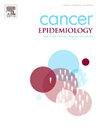Calcium intake and gastric cancer risk: A systematic review and dose–response meta-analysis of observational studies
IF 2.3
3区 医学
Q3 ONCOLOGY
引用次数: 0
Abstract
Calcium has been proposed as a protective factor against certain types of cancer, but findings related to gastric cancer (GC) are inconsistent. This meta-analysis aimed to assess the association between calcium intake and the risk of GC. A comprehensive search was conducted in PubMed, Scopus, EMBASE, LILACS, and Web of Science for cohort and case-control studies published up to August 19, 2024. The quality of the studies was assessed using the Newcastle–Ottawa Scale. Publication bias was tested using Egger’s and Begg’s tests. Relative risks (RRs) and 95 % confidence intervals (CIs) were pooled through a random-effects model. Given the substantial heterogeneity and potential variation in intake levels across populations, a dose-response analysis was conducted to explore potential trends across the full range of calcium consumption. Thirteen studies involving 1,610,992 participants met the inclusion criteria. A non-significant inverse association was observed between total calcium intake and GC risk when comparing the highest vs lowest intake categories (RR: 0.85; 95 % CI: 0.70–1.05). While this categorical comparison was not statistically significant, the dose-response analysis revealed a significant linear protective effect, with a 10 % reduction in risk per 300 mg/day increase in dietary calcium intake (RR: 0.90; 95 % CI: 0.82–0.99). To account for potential variations across intake levels, a non-linear model was also applied, indicating a clearer risk reduction above 400 mg/day (p for non-linearity < 0.001). Overall, this dose-response meta-analysis suggests that higher dietary calcium intake may have a protective effect against GC, reinforcing the importance of considering calcium in dietary strategies for GC prevention, although more studies are needed to confirm these findings.
钙摄入与胃癌风险:观察性研究的系统回顾和剂量反应荟萃分析
钙被认为是预防某些类型癌症的保护因素,但与胃癌(GC)相关的研究结果不一致。本荟萃分析旨在评估钙摄入量与胃癌风险之间的关系。综合检索PubMed、Scopus、EMBASE、LILACS和Web of Science,检索截止到2024年8月19日发表的队列和病例对照研究。研究的质量采用纽卡斯尔-渥太华量表进行评估。发表偏倚采用Egger’s和Begg’s检验。通过随机效应模型汇总相对风险(rr)和95% %置信区间(ci)。考虑到不同人群钙摄入水平的巨大异质性和潜在差异,我们进行了一项剂量反应分析,以探索全范围钙摄入的潜在趋势。13项研究涉及1,610,992名受试者符合纳入标准。当比较最高和最低钙摄入量类别时,观察到总钙摄入量与GC风险之间无显著负相关(RR: 0.85; 95 % CI: 0.70-1.05)。虽然这一分类比较没有统计学意义,但剂量-反应分析显示了显著的线性保护作用,每增加300 毫克/天的膳食钙摄入量,风险降低10 % (RR: 0.90; 95 % CI: 0.82-0.99)。为了解释摄入水平之间的潜在差异,还应用了非线性模型,表明400 mg/天以上的风险降低更明显(非线性<; 0.001)。总的来说,这项剂量-反应荟萃分析表明,较高的膳食钙摄入量可能对胃癌有保护作用,这加强了在饮食策略中考虑钙对胃癌预防的重要性,尽管需要更多的研究来证实这些发现。
本文章由计算机程序翻译,如有差异,请以英文原文为准。
求助全文
约1分钟内获得全文
求助全文
来源期刊

Cancer Epidemiology
医学-肿瘤学
CiteScore
4.50
自引率
3.80%
发文量
200
审稿时长
39 days
期刊介绍:
Cancer Epidemiology is dedicated to increasing understanding about cancer causes, prevention and control. The scope of the journal embraces all aspects of cancer epidemiology including:
• Descriptive epidemiology
• Studies of risk factors for disease initiation, development and prognosis
• Screening and early detection
• Prevention and control
• Methodological issues
The journal publishes original research articles (full length and short reports), systematic reviews and meta-analyses, editorials, commentaries and letters to the editor commenting on previously published research.
 求助内容:
求助内容: 应助结果提醒方式:
应助结果提醒方式:


